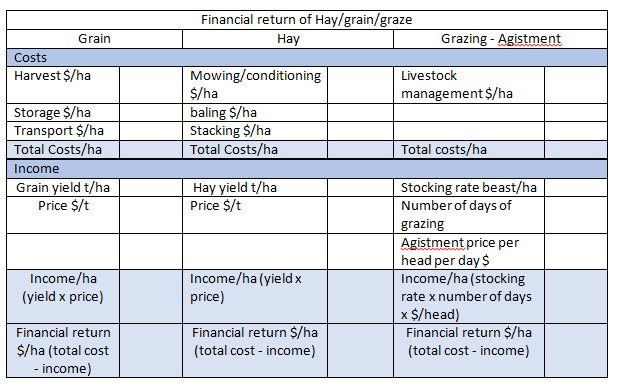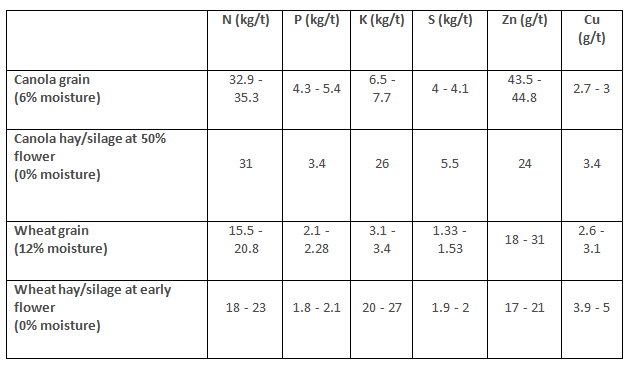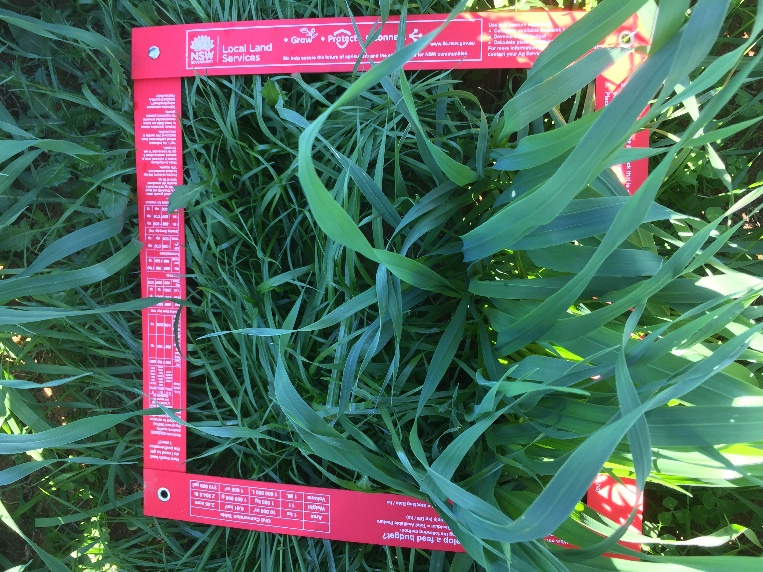Grain, hay or graze: What to do with a failed crop
By Callen Thompson - Senior Land Services Officer Ag Advice
25 September 2019
There are some isolated areas through the Central West where producers were lucky with summer/autumn rainfall and due to good fallow management, were able to grow some crop. The recent hot winds and lack of in crop rainfall have meant that these producers have some tough decisions to make regarding stripping, grazing or making hay out of these crops. In this article I will try to help you make the right decision for your paddock. I will also discuss some often unforeseen costs, like nutrient removal and implications on the following crop.
To calculate the best option financially, we need to estimate grain yield, dry matter yield and know the cost of production and commodity prices. When assessing yields, it is important to go to an area that is representative of the paddock. If there are areas of the paddock that are significantly higher or lower yielding and it is possible to treat them differently, it may be wise to measure them separately. As with all measurements we do in our cropping systems, the more samples you take, the more accurate your results will be. I recommend you take at least ten samples.
Calculating grain yield
As mentioned, find a representative area of the paddock. Measure out a metre of row, then count the number of heads and work out average grains per head. Don’t count heads that are significantly smaller and will not make grain. Within the meter row count the number of grains on ten representative heads. You can count on one side of the head, then double that number.
Then the formula is the number of grains per head, multiplied by the number of heads, multiplied by a factor of 0.027 to 0.029. That’s to take account of grain size per thousand grains, and divided by the row spacing in centimetres. So, if it’s a 25cm row spacing you’d obviously divide by 25.
NSW DPI has a great YouTube tutorial that walks you through the process: www.youtube.com/watch?v=T2lDiX6_7NM
Calculating dry matter
Find an area of the paddock that representative of the whole paddock. Using the Local Land Services Pasture Square, cut herbage inside of the square to ground level and place in a paper bag. The more samples you take the more accurate the result will be.
Weigh each sample individually and record weights. Calculate the average wet weight. Mix samples together then take out a sub-sample. Dry the sub-samples in a microwave. Place sample in the microwave with a separate container with 100ml of water in it. This will reduce the chance of fire.
Cook on high for five minutes, take the sample out and weigh it. Put the sample back into the microwave and cook for a further three minutes, then weigh again. Continue until the final weight equals the previous weight. Do not burn the sample!
The final weight is the dry sub-sample weight (all moisture removed). Use the formula below to calculate kg/DM/ha:
(Dry sub-sample weight (g) / wet sub-sample weight (g)) x average wet weight (g) = dry sample weight
Dry sample weight (g) x 110 = Dry matter per hectare (kg/DM/ha)
(Note: “110” is a factor specific to the LLS Pasture Square).
To calculate the amount of hay you can harvest off the paddock, you take the dry matter per hectare value, then add 10% to account for moisture. You then take away 20% for harvest loss. If you have to cut the paddock higher than normal, you can do the initial herbage cut at mowing height. Keep in mind that you will still need to do the grazing calculations from a herbage cut at ground level.
Calculating stocking rate
Some producers will have stock on hand, while others will be looking at buying in trading stock or providing agistment. For ease of providing an example, I am using agistment stock but you can still do the same comparison for other options if you know how many stock you can graze and the number of days grazing. The following calculations will give you the stocking rate per hectare.
Dry matter per hectare (kg/DM/ha) - Desired residual = Available pasture
Available pasture - wastage (30%) = Net supply (kg/DM/ha)
Net supply/(intake per head (3% of body weight) x grazing days required)= stocking rate per hectare
Financial return
To calculate the financial return of each option, we need to know our cost of operations and the commodity price of each product. Filling in the following table will allow you to calculate which the best option in terms of financial return is. You may need to include other costs depending on your system, especially for the grazing option.

Nutrient removal
Nutrient removal differs from grain to hay. The below table is data collected by Incitec Pivot from paddocks on the Riverine Plains, Victoria. It is possible to use this data combined with the grain and dry matter yields above to calculate nutrient removal per hectare. Once you know the removal per hectare it is possible to calculate the rate of fertiliser needed to replace removal. The cost of replacement is dependent on the fertiliser you use to replace the particular nutrient. In fertile soils, you may not get an economic response replacing nutrients that are in high abundance.

Removal of organic matter and ground cover
Organic matter including standing stubble improves the soils ability to hold moisture and nutrients as well as improving water capture and infiltration. Removing crop residues through harvesting hay or grazing can also reduce fallow efficiency and in summer conditions, decrease crop establishment as soils dry out more quickly. Many producers I speak to are taking their paddocks through to grain, even though yields will be low, so they can maintain or increase ground cover. This will limit the chances of wind and water erosion.

The LLS Pasture square is a great tool for measuring a metre of row or to work out dry matter per hectare
Like all aspects of farming, you need to weigh up what works best for your business. There is economic, nutrition and future crop factors that will influence your decisions. If you would like further information or help making grain, hay or graze decisions, please contact your local LLS Ag Advisor.